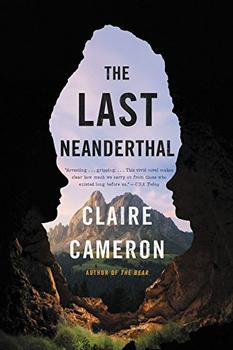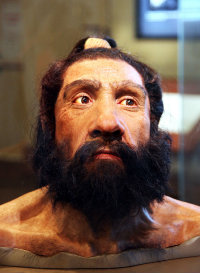Summary | Excerpt | Reading Guide | Reviews | Beyond the Book | Read-Alikes | Genres & Themes | Author Bio

This article relates to The Last Neanderthal
Claire Cameron's The Last Neanderthal stirs interest in our closest evolutionary relative, Homo neanderthalensis.
 Evidence from both fossil and genetic research suggests that Neanderthals and modern humans evolved from a common ancestor between 500,000 and 200,000 years ago. Neanderthals lived in Europe and southwestern and central Asia. The regions inhabited by Neanderthals overlapped with early Homo sapiens for some period of time, and interbreeding is confirmed: most modern humans have between 1% and 4% Neanderthal DNA.
Evidence from both fossil and genetic research suggests that Neanderthals and modern humans evolved from a common ancestor between 500,000 and 200,000 years ago. Neanderthals lived in Europe and southwestern and central Asia. The regions inhabited by Neanderthals overlapped with early Homo sapiens for some period of time, and interbreeding is confirmed: most modern humans have between 1% and 4% Neanderthal DNA.
The Neanderthals were not much different from us. National Geographic's GENOgraphic project's web page on Neanderthals states that a "growing number of scientists have argued that the Neanderthals' similarities to modern humans far outweighed any differences." Some comparisons include:
Our cultural characterization of Neanderthals tends to be animalistic – including adjectives such as grunting, stooped, club-wielding, or hairy. Claire Cameron's depiction challenges this long-held stereotype and makes one wonder how Neanderthals may have interacted with early humans.
New research is shifting those earlier assumptions; Cameron describes how, in an interview published in Canadian Notes & Queries. For example, prior to the 1980s, it was assumed that Neanderthals were not capable of speech – thus we imagined a "grunting" being. But in the eighties, archaeologists found bones matching the ones in Homo sapiens that anchor the tongue, and enable human speech. In addition to finding that bone and Neanderthal remains, scientists have also discovered, through genetic research, that Neanderthals possessed the gene that – for us – is important for speech.
The caricature of "stooped" can also be explained away. Much of what was originally known of Neanderthals came from a specific Neanderthal skeleton which can now be viewed in the context of additional skeletons as well as advanced scientific methods. Says Cameron, "It took almost 50 years and a thorough re-examination of the artifacts to establish that the Neanderthal remains actually belonged to an old man who was toothless and suffered from osteoarthritis, hence the stooped posture."
It isn't clear why the Neanderthals went extinct around 40,000 years ago, but some current theories include climate change and competition from Homo sapiens. Then there is the argument put forward by Briana Pobiner, paleoanthropologist at the Smithsonian's National Museum of Natural History, who points out that "everyone alive today whose ancestry is from outside of Africa (where Neanderthals never lived) carries a little bit of Neanderthal DNA in their genes." It is a compelling concept that may be answered by future discoveries.
Pictures from Tim Evanson, Smithsonian Museum of Natural History
Filed under Medicine, Science and Tech
![]() This "beyond the book article" relates to The Last Neanderthal. It originally ran in June 2017 and has been updated for the
April 2018 paperback edition.
Go to magazine.
This "beyond the book article" relates to The Last Neanderthal. It originally ran in June 2017 and has been updated for the
April 2018 paperback edition.
Go to magazine.






Your guide toexceptional books
BookBrowse seeks out and recommends the best in contemporary fiction and nonfiction—books that not only engage and entertain but also deepen our understanding of ourselves and the world around us.